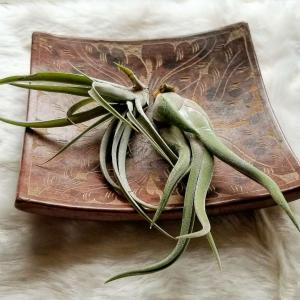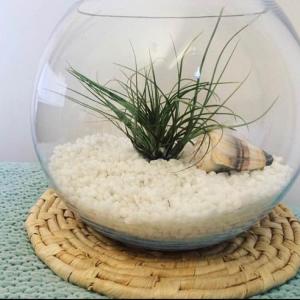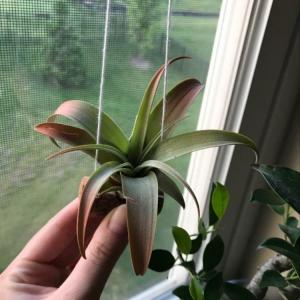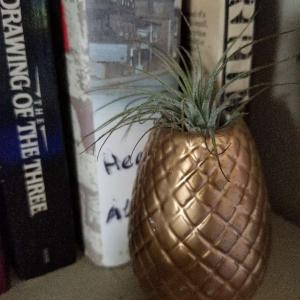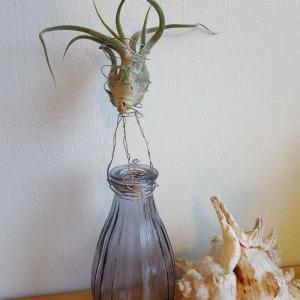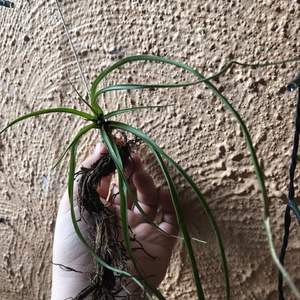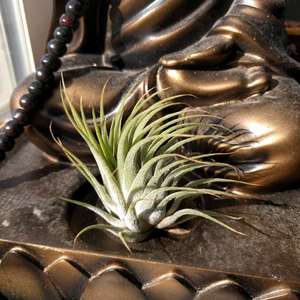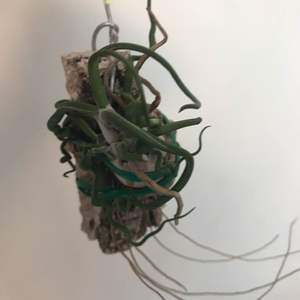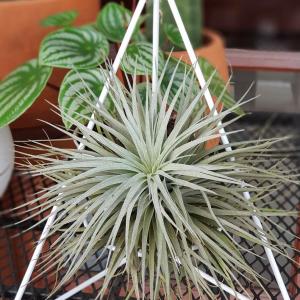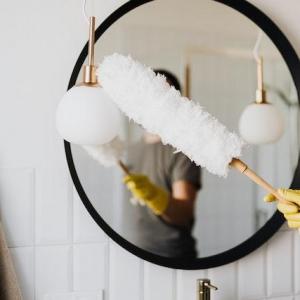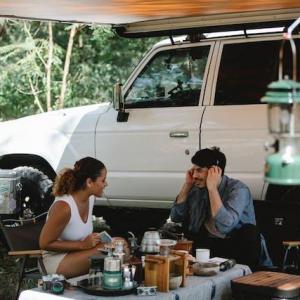Plant Experience
Detail
Air Plants, also known as Tillandsia, are some of the easiest plants to grow. While they are called "air plants" they still need water, nutrients, and light to survive. Air Plants are technically Epiphytes, meaning that they grow on another tree, host, or object. However, they do not steal nutrients from their host, only using it as a home to grow on. Air plants use tiny vessels located throughout their leaves called trichomes to capture nutrients and moisture from the air.
The amazing thing about air plants is that they use their roots to anchor themselves to an object, which allows them to grow in a variety of locations naturally. This flexibility of growth allows air plants to be used in a variety of scenarios which has lead to increased popularity of Tillandsia as decorations for homes and offices.
While air plants are known for being easy to grow, they still do need attention to survive and live a healthy life. If taken care of properly, Tillandia can live for several years and will even provide "pups" for additional years of enjoyment!
LIGHT:
One of the most important things any living creature needs is light, and air plants are no exception. If you are keeping your plants indoors, you will want to make sure that they are near an adequate light source. This can be within 3-5 feet of a window, or near an artificial light source. Take care to not let your air plants get too much direct sun, as this can be harmful, even in an indoor environment. If you are keeping your plants outside, make sure they are in a shaded area that does not receive full sun. There are only a few varieties that can handle direct sun.
Air plants love being placed in a bathroom or kitchen window (indirect light), and the steam/moisture will keep them happy!
Artificial light can also be a sufficient source, as long as the plants are not too far from the light and receive adequate amounts per day.
WATER:
If you keep your air plants indoors, they will be healthiest with watering at least once a week. Plants that are constantly being dried out from A/C or heaters will require more moisture than a plant that is located in a more humid environment. You can also mist your plants as needed in between watering, but misting should not be used as a sole source of moisture in most cases.
Place the plants face down in a bowl, sink, or container and lets soak for 10-20 minutes. Always take care to gently shake any excess water off the base of the plants, as sitting water can cause rot and damage/kill the plant. We recommend that you water the plants in the morning, and leave them out of their containers in an area that they can dry within 4 hours. Never let your air plant sit in water for a prolonged period of time. You can also water your plants using the "dunking" method, where you dunk the plants several times in the water, and gently shake off any excess.
If your plant is struggling and looks "thirsty" you can leave them in bowl for a longer soak of a few hours or even overnight. A healthy air plant will have wide open leaves while a dehydrated air plant will have closed and curled leaves! Never submerge the bloom or flower, as it can cause the flower to rot.
If you are using tap water, let the water stand for several hours to dissipate any chemicals prior to watering the plants. When possible its best to use pond, aquarium, or rain water. Bottled water and spring water are also ok to use, but never use distilled or artificially softened water!
Remember that each plant variety is different, and will require different watering schedules than others. Never put your air plants in soil, it will harm them!
AIR:
Another important variable that is important to your Air Plant, is you guessed it...Air! The plants will need good clean air circulation to survive and live a healthy life. Its important that after watering the plants have enough air circulation to dry within 4 hours. While Air Plants will do well in containers, it is recommended that they do not be displayed in enclosed containers, and that they are completely dry before they are put back into a container that might restrict air circulation.
Plants located too close to A/C vents may dry out sooner and require more frequent hydrating.
TERRARIUMS/GLOBES:
If you are planning on keeping your air plants in a terrarium or globe, you will need to remove the plant for normal watering, and make sure to leave the plant out until is has had enough time to completely dry. Usually 4 hours will do. When the tillandsia is in the terrarium or globe, you can give it periodic mistings to create some humidity. The smaller and more compact the globe, the less mistings you will want to give your plants. If the terrarium is larger and has better air circulation, you can give it a few sprays from a water mister a few times a week. Just make sure to take care in ensuring the plant does not get over misted, and that it dries within a few hours while in the terrarium.
TEMPERATURE:
Air Plants are found in a wide variety of temperatures, but mainly range from 50-90 degrees Fahrenheit. If you live in an area with freezing conditions, make sure your air plants are safe indoors!
FERTILIZER:
Bromeliad fertilizer can be used once a month in small quantities. You can also use orchid or any other indoor plant fertilizer that has low copper contents. Air Plants can be sensitive to fertilizers so make sure not to over do it!
TRIMMING:
Over time your air plants will grow new leaves, and loose some. Feel free to trim any brown or dead leaves off your plant with scissors, trimming at an angle to give the end of the leaf a nature appearance after trimming. Most air plant varieties will be shipped with roots intact, and can removed if you like. The roots are solely used to anchor the plant to its host, and can be kept on the plant and used to anchor your plant to a display with a little superglue or hot glue.
PUPS:
As your air plant begins to mature and run through its bloom cycle, it will produce babies also known as "pups". You can either remove the pup once it reaches around 1/3 of the size of the mother plant, or you can leave the pups on and they will eventually form a "clump". An air plant "clump" can be hung be a string and is sure to impress as it grows and continually blooms!
The amazing thing about air plants is that they use their roots to anchor themselves to an object, which allows them to grow in a variety of locations naturally. This flexibility of growth allows air plants to be used in a variety of scenarios which has lead to increased popularity of Tillandsia as decorations for homes and offices.
While air plants are known for being easy to grow, they still do need attention to survive and live a healthy life. If taken care of properly, Tillandia can live for several years and will even provide "pups" for additional years of enjoyment!
LIGHT:
One of the most important things any living creature needs is light, and air plants are no exception. If you are keeping your plants indoors, you will want to make sure that they are near an adequate light source. This can be within 3-5 feet of a window, or near an artificial light source. Take care to not let your air plants get too much direct sun, as this can be harmful, even in an indoor environment. If you are keeping your plants outside, make sure they are in a shaded area that does not receive full sun. There are only a few varieties that can handle direct sun.
Air plants love being placed in a bathroom or kitchen window (indirect light), and the steam/moisture will keep them happy!
Artificial light can also be a sufficient source, as long as the plants are not too far from the light and receive adequate amounts per day.
WATER:
If you keep your air plants indoors, they will be healthiest with watering at least once a week. Plants that are constantly being dried out from A/C or heaters will require more moisture than a plant that is located in a more humid environment. You can also mist your plants as needed in between watering, but misting should not be used as a sole source of moisture in most cases.
Place the plants face down in a bowl, sink, or container and lets soak for 10-20 minutes. Always take care to gently shake any excess water off the base of the plants, as sitting water can cause rot and damage/kill the plant. We recommend that you water the plants in the morning, and leave them out of their containers in an area that they can dry within 4 hours. Never let your air plant sit in water for a prolonged period of time. You can also water your plants using the "dunking" method, where you dunk the plants several times in the water, and gently shake off any excess.
If your plant is struggling and looks "thirsty" you can leave them in bowl for a longer soak of a few hours or even overnight. A healthy air plant will have wide open leaves while a dehydrated air plant will have closed and curled leaves! Never submerge the bloom or flower, as it can cause the flower to rot.
If you are using tap water, let the water stand for several hours to dissipate any chemicals prior to watering the plants. When possible its best to use pond, aquarium, or rain water. Bottled water and spring water are also ok to use, but never use distilled or artificially softened water!
Remember that each plant variety is different, and will require different watering schedules than others. Never put your air plants in soil, it will harm them!
AIR:
Another important variable that is important to your Air Plant, is you guessed it...Air! The plants will need good clean air circulation to survive and live a healthy life. Its important that after watering the plants have enough air circulation to dry within 4 hours. While Air Plants will do well in containers, it is recommended that they do not be displayed in enclosed containers, and that they are completely dry before they are put back into a container that might restrict air circulation.
Plants located too close to A/C vents may dry out sooner and require more frequent hydrating.
TERRARIUMS/GLOBES:
If you are planning on keeping your air plants in a terrarium or globe, you will need to remove the plant for normal watering, and make sure to leave the plant out until is has had enough time to completely dry. Usually 4 hours will do. When the tillandsia is in the terrarium or globe, you can give it periodic mistings to create some humidity. The smaller and more compact the globe, the less mistings you will want to give your plants. If the terrarium is larger and has better air circulation, you can give it a few sprays from a water mister a few times a week. Just make sure to take care in ensuring the plant does not get over misted, and that it dries within a few hours while in the terrarium.
TEMPERATURE:
Air Plants are found in a wide variety of temperatures, but mainly range from 50-90 degrees Fahrenheit. If you live in an area with freezing conditions, make sure your air plants are safe indoors!
FERTILIZER:
Bromeliad fertilizer can be used once a month in small quantities. You can also use orchid or any other indoor plant fertilizer that has low copper contents. Air Plants can be sensitive to fertilizers so make sure not to over do it!
TRIMMING:
Over time your air plants will grow new leaves, and loose some. Feel free to trim any brown or dead leaves off your plant with scissors, trimming at an angle to give the end of the leaf a nature appearance after trimming. Most air plant varieties will be shipped with roots intact, and can removed if you like. The roots are solely used to anchor the plant to its host, and can be kept on the plant and used to anchor your plant to a display with a little superglue or hot glue.
PUPS:
As your air plant begins to mature and run through its bloom cycle, it will produce babies also known as "pups". You can either remove the pup once it reaches around 1/3 of the size of the mother plant, or you can leave the pups on and they will eventually form a "clump". An air plant "clump" can be hung be a string and is sure to impress as it grows and continually blooms!
Album (1)
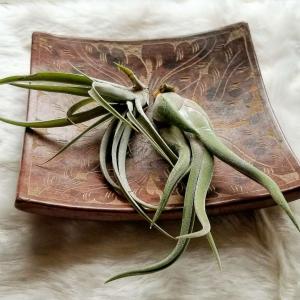
brielle
2017-10-07

This is my first growing diary.


Related Users
Elite Article


